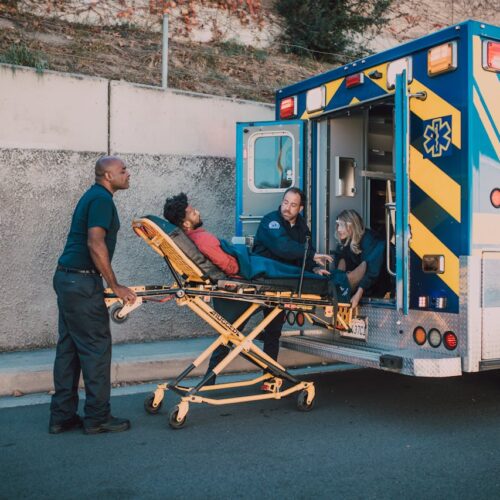Reentry Programs and the Researchers Who Evaluate Them: What It Takes to Build an Effective Partnership
CSG Justice Center staff spoke with four Second Chance Act (SCA) Innovations in Reentry Initiative grantees—New York City’s Harlem Reentry Court; the Executive Office of the Governor of Delaware’s Individual Assessment, Discharge, and Planning Team (I-ADAPT) Program; the Indianapolis, Indiana, Department of Public Safety Second Chance Act Offender Reentry Project; and the Alameda County, California, Transition Day Reporting Center (TDRC) Demonstration—about their experiences fostering effective partnerships between criminal justice practitioners and the researchers evaluating their programs. These programs span the country and the justice system, serving clients within courts, prisons, jails, and in the community.
Increasingly, reentry programs and initiatives across the country are partnering with evaluators to better understand the effectiveness of their recidivism reduction strategies and identify ways to use data to further refine their practices.
At the forefront of this trend are grantees of the SCA Innovations in Reentry Initiative (IRI): state and local government agencies and tribal governments that have received funding from the U.S. Department of Justice’s Bureau of Justice Assistance to develop comprehensive and collaborative strategies to address reentry challenges for people leaving prisons and jails. IRI supports the development of practitioner-evaluator partnerships that use research and data to identify challenges and develop effective and economical strategies to improve reentry practices.
Throughout its programmatic activities, IRI emphasizes research—a focus that necessitates effective partnerships. When surveyed, IRI grantees not only highlighted the importance of data, but also articulated three other themes that they felt were needed for a successful practioner-evaluator relationship: clear roles and responsibilities, effective communication, and leadership support.
“The numbers don’t tell the whole story,” said Daniel O’Connell, senior scientist at the University of Delaware’s Center for Drug and Health Studies, which completed the evaluation of Delaware’s I-ADAPT Program. “So you can’t make the numbers your end goal. You have to be present, listening to what people are trying to accomplish and watching the program evolve. That’s how you get the full story.”
Effective collaboration happens when both evaluation staff and program staff are clear about their roles and responsibilities and are open to learning about the inner workings of the systems they each work in.
At the outset of the evaluation period, having agency leadership introduce the evaluator as a team member who is there to help improve program outcomes—instead of as someone who is there to monitor the work of program staff—can help create an open, communicative environment in which program staff may feel more comfortable discussing issues and solutions with the evaluator. Through this relationship, evaluators can identify potential challenges to data collection, understand why actions may not align with protocols, understand perceptions of success, and learn more about the culture of the agency.
In Practice
Through its Reentry Court, the Harlem Community Justice Center (Justice Center) connects high-risk people returning to New York County from New York state prisons to substance addiction treatment and other intensive support services. Participants in the court are required to appear before an administrative law judge regularly to ensure their compliance with treatment mandates and parole conditions.
During her evaluation of the Reentry Court, Lama Hassoun Ayoub, deputy director of research at the Center for Court Innovation, built relationships with court participants’ parole officers and sat in on court sessions to develop a better understanding of the program environment.
“I always try to emphasize that an evaluation is not a judgment of the staff—I’m not there to tell you whether or not a parole officer is doing a good job; I’m there to help figure out how to make the program the best it can be,” Hassoun Ayoub said. “Be clear about what you can do for staff, as well as what you’re going to ask them to do for you, and always be sensitive to the culture and the priorities of the practitioners in the program. My research means nothing if it doesn’t take those things into account.”
On the practitioner side, Justice Center Deputy Project Director Debbie Boar said having an evaluator understand what a day in the life of program staff looks like is the first step in “determining [not only] if programs are implemented to fidelity, but also if the program is providing the staff the tools they need to be successful.”
Tips
- Job descriptions and titles of all program staff, research staff, and partners should be shared at the outset of the initiative so that everyone’s roles are memorialized in writing.
- All tasks associated with the initiative should have clear objectives, designated staff, and deadlines so the team knows who is responsible for what aspect of the work and when it will be accomplished. Lay these tasks out during interagency planning discussions and make sure all parties agree before the roles and responsibilities are decided and delegated.
- Evaluators should familiarize themselves with the corrections system in their jurisdiction to better understand how programming, movement, and staff culture intersect.
- Evaluators should receive training on cognitive behavioral programming so they can better understand the ways the programs are used by staff.
Fostering strong partnerships between practitioners and evaluators also requires regular and open communication.
Leadership must find an evaluation partner who shares the vision of the practitioners involved in the program or initiative. Early on, program staff and evaluation staff should convene a meeting to identify common goals, set expectations, and establish protocols that outline how often all involved parties will communicate and which methods of communication—email, phone, or web-based or in-person meetings—will be used.
Before an evaluation even begins, it is essential for the practitioners and evaluators to “speak the same program language”—establish common definitions of terms like recidivism, program success, programming dosage, and others, to ensure clear communication throughout the evaluation process.
Once a common language is established, maintaining open lines of communication between program staff and evaluators is key to ensuring cohesion across the team. Methods of communication may vary from program to program, but evaluators and program staff should communicate frequently and update each other on research and program progress every step along the way.
In Practice
As part of the Indiana Department of Public Safety’s Second Chance Act Offender Reentry Project, Marion County partners with Community Solutions—an Indianapolis nonprofit—to match a care coordinator with high-risk, high-needs 18- to 25-year-olds who are in jail because of a probation violation. When participants are released from jail and return to community supervision, their care coordinators refer them to programs and services to address their assessed risk and needs. To make these connections to services, Community Solutions taps into the Marion County Re-Entry Coalition (MCRC), which comprises representatives from other community- and faith-based organizations, criminal justice agencies, employers, and advocates.
MCRC representatives host regular, in-person meetings with the Reentry Project’s evaluation partners from the American Institutes for Research. During these meetings, care coordinators share updates on the progress of program participants and the evaluation partners discuss research findings. Convening the many partners of the coalition on a frequent basis might sound difficult, but “we often run out of chairs for all the people who show up,” said Principal Researcher G. Roger Jarjoura. Jarjoura attributes this commitment among the partners to the collaborative environment they’ve nurtured in each of their meetings.
“When we’re all at the table and questions come up, we’re not hearing ‘Nope, we can’t do that.’” Jarjoura said. “Everybody that’s involved in the collaborative brings the spirit of ‘Let’s figure this out.’”
Tips
- Whenever possible, have evaluation staff co-locate with program staff. If the evaluation partner is located in another city or state, consider having them select an embedded criminologist who will be on site for the duration of the evaluation to ensure smooth and constant communication.
- Make sure communication remains consistent. Include all the partners in emails about program updates, however small; maintain regular check-ins; and discuss research findings at several points during the evaluation process so program adjustments can be made.
Support from leadership who recognize the importance of the evaluation process is essential to the long-term success of any reentry program or initiative.
Throughout the course of an evaluation, research findings may show that significant changes need to be made to longstanding, agency-wide policies, or that new practices need to be developed altogether in order to improve program outcomes. Engaging high-level leaders from departments of corrections and other criminal justice agencies will help ensure that those policies and practices are properly implemented. Additionally, getting elected officials and community leaders on board with the goals and mission of the reentry program or initiative early on, and providing these champions with the information they need to endorse the efforts, can lead to sustainability after the grant ends.
In Practice
Delaware’s I-ADAPT Program was created in 2009 in response to then-Governor Jack Markell’s mandate that the secretaries of the Departments of Corrections, Health and Human Services (HHS), Labor, Housing, and Education come together to build a statewide reentry initiative to reduce the state’s recidivism rate and enhance public safety. Under I-ADAPT, hand-picked representatives from each of the five state agencies worked together to create a comprehensive, holistic approach to reentry planning designed to address people’s needs from the moment they’re admitted into prison through the months following their release.
For Jay W. Lynch, Social Services senior administrator for Delaware’s HHS, the most notable characteristic of all the people involved in the creation and continuation of I-ADAPT—from the governor to the program and evaluation staff—is that they are “purpose driven.”
“The I-ADAPT Oversight Team is comprised of people not trying to promote themselves, but [to promote] a higher cause,” Lynch said. “People who are purpose driven discover something bigger than themselves—a mission, a challenge, a goal, or a movement that draws them into the arena.”
Delaware’s reentry initiative demonstrates the success that follows when leadership is committed to the project. Across the country in Alameda County, California, Department of Probation Chief Wendy Still has led the charge to enhance the services offered at the TDRC, which serves medium- and high-risk adults who are returning to Alameda County after incarceration. Chief Still returned from retirement—having previously served as the chief of the San Francisco Probation Department—to establish system-level changes in Alameda.
As part of the initiative, Chief Still partnered with Dr. Faye Taxman of George Mason University’s Center for Advancing Correctional Excellence to evaluate the TDRC’s use of tiered, coordinated services for clients based on their levels of assessed risk and needs.
“Transformative leaders make or break initiatives,” Dr. Taxman said of Chief Still’s commitment. “Organization-wide change needs to be deliberate … and the leaders should empower staff to use their creative energies to develop, design, and implement innovative [ideas] … A good leader is priceless.”
Tips
- High-level leaders should be present in early meetings or kick-off events to show line staff that the initiative is a priority for them.
- Informational sessions with leaders should begin at the onset of planning to build support. These meetings should include both program staff and evaluation staff to share different aspects of the work and its potential impact.
To learn more about IRI, visit the grant program page, or read about the work of grantees in Washington and New Jersey.
In response to growing calls for police reform in New Jersey, particularly following the shootings of Najee Seabrooks…
Read More Three Things to Know About New Jersey’s Groundbreaking Community Response Legislation
Three Things to Know About New Jersey’s Groundbreaking Community Response Legislation
In response to growing calls for police reform in New Jersey, particularly…
Read More Apply Now: Join a Learning Community for Community and Crisis Response Teams to Improve Responses to Youth
Read More
Apply Now: Join a Learning Community for Community and Crisis Response Teams to Improve Responses to Youth
Read More
 Apply Now: Join a Learning Community Focused on Substance Use and Overdose Community Response Programs
Read More
Apply Now: Join a Learning Community Focused on Substance Use and Overdose Community Response Programs
Read More













